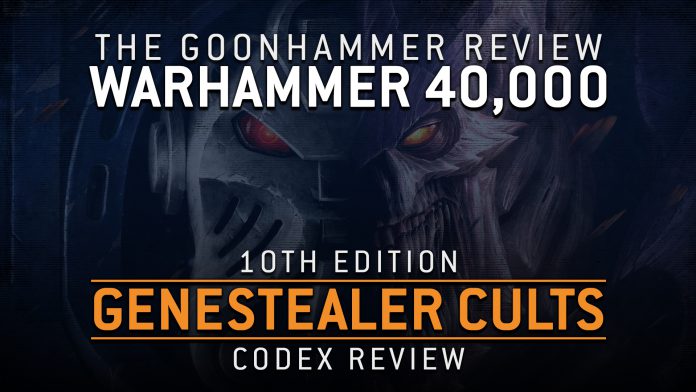The Genestealer Cults have emerged from hiding to set all of the Imperium on the Path to Ascension. We’ve already looked at how the faction is likely to stack up in matched play, so now it’s time to take a look at the Crusade rules and dive into the nitty-gritty of how your average planetary-scale revolution actually works in practice.
Thanks as always to Games Workshop for providing us with a copy of the codex for this review.
Path of Ascension
The Cults’ minigame starts from the same pitch as it did in 9th edition: generate the planet that your Cult was seeded onto, complete Agendas and play games to infiltrate the planet’s institutions and expand your cult without being caught, and ultimately reveal your scheme at the Day of Ascension. Depending on how well you’ve done over the course of your mini-campaign, you’ll either take control of the planet in one fell swoop, leave the planet behind in search of other, better prey, or get caught out and have to fight for survival as the planet’s defenders try to purge it of the Genestealer taint.

As presented, your goal is to progress along the Path of Ascension while avoiding detection by the powers-that-be on the planet. To do this, you want to generate Ascension points by winning games and completing agendas from this book. Then, once you get 3 Ascension points, you cash them in for a Control point and a nice little one-off bonus in the form of a Controlled Institution Benefit. Next, you can optionally try to gain a Propagation point by rolling a 5+ on a d6. If you’re successful, you lose a Control point if you had more than one. Once you’ve done all of this, roll 2d6 and add your Control count to find out if you’ve been discovered. Rack up 4 Control points or 5 Propagation points, and you win. Get caught, and your next battle will be fought in the Great Ordeal, which aims to simulate the dramatic all-or-nothing conflict that arises when a Patriarch realizes they’ve got one last chance before the forces of the Imperium wipe them out. It accomplishes this by handing your opponent a few extra CP depending on how many Control points you’ve managed to rack up.
Sounds pretty cool, right? And it would be, if it didn’t take forever to gain enough Control points to win. I’ll spare you the math, but if you’re chasing a Glorious Ascension victory to try to claim the planet’s Ascension reward, you’re looking at 11 games or so, assuming you don’t spend any RP. If you decide to chase a Seed the Stars victory instead, you’ll be rolling for Propagation after every game, and you’ll have done so an average of 15 times before you manage to pull this off. In other words, neither of these are realistically achievable at a Crusade weekender.
Oddly enough, if you’re looking to actually pick up any of the Ascension rewards–and you should, they’re pretty good–the best way to do so is to try to get caught. Complete the Prepare for the Ordeal agenda your first game to minimize your opponent’s advantage, then aim to complete both Genestealer’s Kiss and Telepathic Domination to add +2 to your Setback roll and pray for a 13 or higher. Then, simply win your next game. Easy, right?
There’s just one catch: failure hurts. Lose the Great Ordeal battle, and you have to choose between losing an Ascension reward you’ve already gained or giving each and every Patriarch, Primus, and Magus on your roster a Battle Scar. Rough. Thankfully, while you can’t take the Battle Scars if you don’t have any units to take them, there doesn’t seem to be anything stopping you from losing an Ascension reward if you don’t have one of those. This means that even if you get caught on your first attempt to take over a planet, you don’t really have anything to lose. But once you’ve achieved some sort of victory on the Path to Ascension at least once, failure in the Great Ordeal may no longer be a risk you’re willing to take. And the chances of getting discovered aren’t even that great until you’ve played a few games anyway; even if you’re trying to be discovered, you’re likely to make it through the first 5 games of a campaign without the Arbites crashing your party, which means the chances you’ll even play a Great Ordeal game are fairly slim.
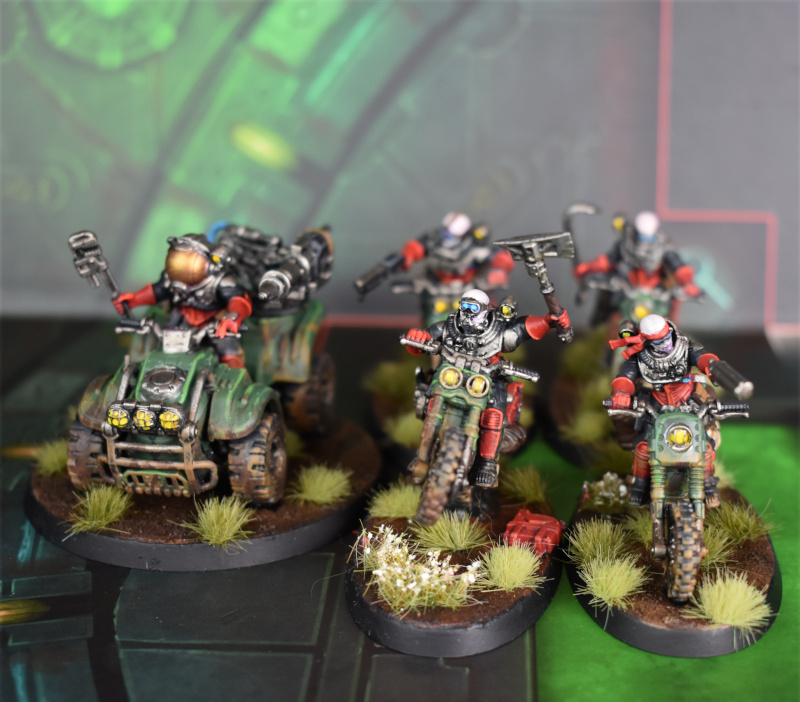
All said and done, the only real problem here is that it takes too long to complete compared to other Crusade rules. Where factions like Space Marines are more or less guaranteed at least one reward for their efforts by the time they’ve played 4 games, the Genestealer Cults are likely to have to wait until they’ve played 10 or more games in order to see any of their Ascension rewards, and they’re more likely than not to be discovered by the Arbites on their way there.
This isn’t to say these rules aren’t salvageable. If you’re running your local Crusade campaign, consider tweaking the numbers to speed up the rate at which GSC players take control of the various institutions. But if you’re going into this using the rules as written, be warned: the Path to Ascension is a long one.
Ascension Rewards
But what are the rewards on offer for completing the Path to Ascension? If you managed a Seed the Stars victory by making 5 successful Propagate rolls, you’ll choose any 3 characters in your Crusade roster to gain 2XP, then start over with a new planet that has 2 infiltrated institutions instead of the normal 1. But for the average 15 games it’ll take you to get there, Seed the Stars probably isn’t it.
Instead, you’ll want to chase either a Glorious Ascension or Great Ordeal victory. In addition to giving 2XP to one of your Patriarchs, you’ll also get an Ascension reward determined by the type of planet that you’re taking over. Target a Hive World, and you’ll benefit from the Strength of the Masses, which gives 1XP to every Battleline unit from your roster that survives a battle. If you’ve taken over a Forge World, your Prized Acquisition means that every new Vehicle you add to your Order of Battle starts at 6XP, pushing them to the Blooded rank and giving them a Battle Honour. Conquering a Frontier or Feudal World grants you a Cult of Personality, which gives an extra 1XP whenever you choose a unit to be Marked for Greatness. The Hard Graft of the residents of an Agri or Mining World lets you gain 1RP on a 4+ after every game, and a Cardinal World’s Will of the Faithful lets you ignore the first failed Out of Action test after every game. Both of these are potent bonuses given how many Out of Action tests you’re likely to be taking and the Battle Scars that come with them. But our favorite is the Looted Armoury you’ll get from controlling a Fortress World: as long as you have this bonus, whenever a unit on your roster gains a Weapon Modification, you roll 3d6 on the table instead of 2d6. As an added bonus, if you managed to achieve a Glorious Ascension, your next Path to Ascension will start with 2 infiltrated institutions.
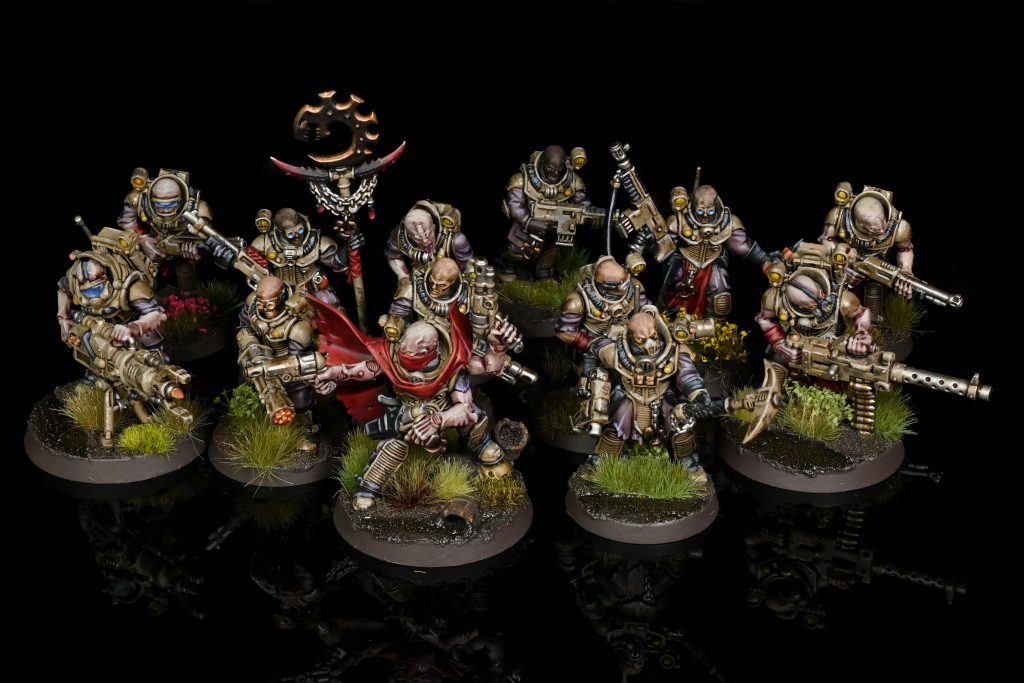
These rewards are solid, but given the amount of time it’ll take for you to get one, you shouldn’t be planning your entire Crusade around them. Instead, look at them as nice bonuses if you can pull them off, and focus on the rest of the stuff in this book.
Agendas
The Cults have five agendas, and they’re largely unchanged from 9th edition, which is a good thing, since they were already fine. If you’re looking to cause trouble, your Patriarch and any Purestrain ‘Stealers in your roster can offer their victims the Genestealer’s Kiss, and gain 1XP for each enemy unit they destroy. Alternatively, you can have one or more of your psykers perform an action for Telepathic Domination within 18” of your opponent’s battlefield edge to gain 1XP each time they complete it. Regardless of which you complete, if you’re on the Path to Ascension, this sort of overt Xenos or psychic activity draws the attention of the planetary authorities. If you gain 3XP from Genestealer’s Kiss or 2XP from Domination, you’ll add 1 to your next Setback roll, making you more likely to get caught and have to fight in the Great Ordeal. However, unlike their 9th edition counterparts, neither of these agendas will add to your Ascension roll, so while you might find yourself taking one of these so you can use the Flawless Incursion requisition, you won’t be looking to max them out unless you’re actively trying to trigger the Great Ordeal.
If you want to be a bit more subtle, you can nominate an enemy CHARACTER unit who’s been talking trash about your Cult and attempt the Silence Detractor agenda. If one of your units kills the unit you chose, it gains 2XP. And if the unit that accomplished this agenda contained a Sanctus, Locus, Kelermorph, or Jackal Alphus, their efforts to silence that detractor have paid off: you’ll make a note on your order of battle that allows you to subtract 1 from a single Setback roll. Given how easy it is to get the XP from this Agenda, you’ll probably be taking it in most of your games, and the -1 to your Setback roll is a nice bonus.
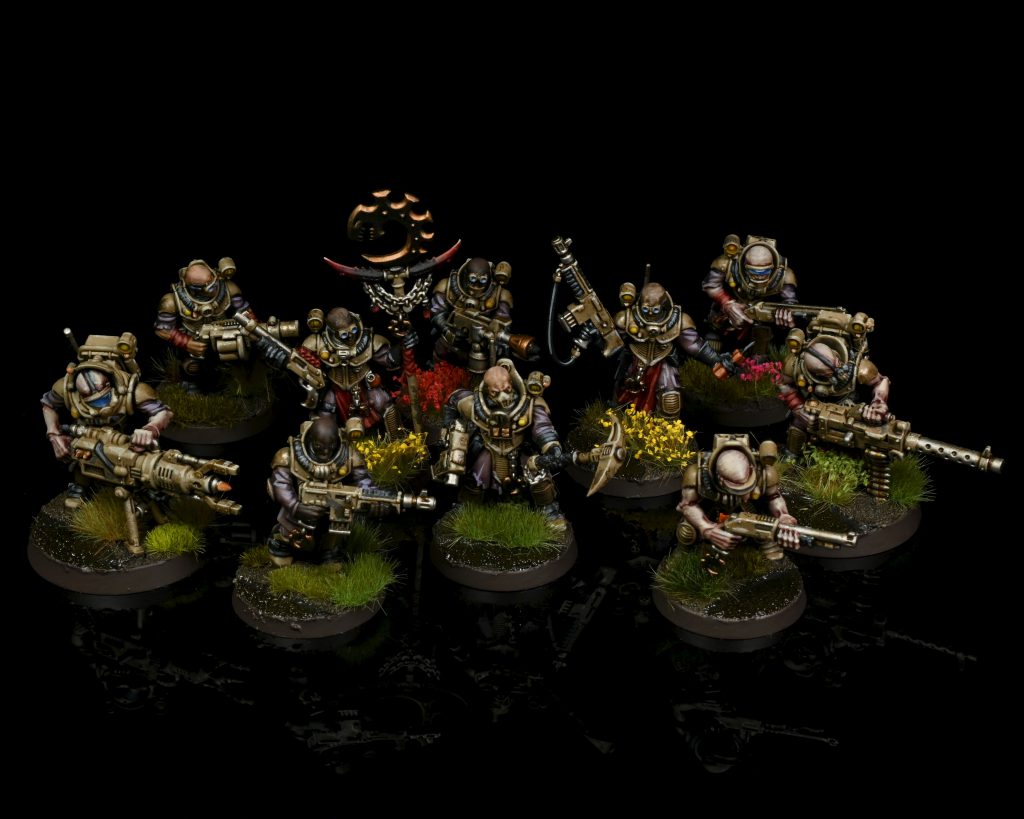
Prepare for the Ordeal has your units digging tunnels, setting traps, and preparing other nefarious plots in advance of the final, climactic battle for the fate of their world. To do so, you’ll choose a Battleline unit from your army to perform an action while within a terrain feature. If they manage to hang on until the start of your next turn, they’ll gain 2XP and that terrain feature is “Prepared,” meaning you can’t target it for this agenda again. Pull this off for 3 different terrain features, and you’ll be Prepared for the Ordeal, which gives you 2XP to start the battle when you’re inevitably caught and forced to fight in the Great Ordeal.
The last agenda is probably our favorite, though: Topple the False Temple has your opponent choose a Ruins terrain feature to be their “false temple.” Then, one of your Battleline or Reductus Saboteur units that’s in the false temple and more than 3” away from enemy units can take an action to try to sabotage it. If that unit is still in the false temple at the start of your next Command phase, the false temple is Toppled and your unit gains a juicy 4XP. That means that the terrain feature no longer counts as a Ruin, and true line of sight applies to it for the rest of the game. This is a really cool effect that plays with the rules of 40k in unexpected ways.
Requisitions
We’ll start the Requisitions off with Flawless Incursion. You can only spend it if you win a game, took nothing but Genestealer Cults Agendas, and gained at least 1XP from those Agendas, but the reward is worth it: you gain an extra Ascension point. In other words, if you’re winning half your games, you’ll move along the Path to Ascension 1.5 times faster. Given how long it takes to progress that mechanic, you’ll want to be spending this after every game you win.
That’s not the only Requisition you’ll be using a lot, though: expect to spend RP on Proficient Planning before most of your games as well, especially if you find yourself missing the army upgrades from 9th edition. For 1RP, this requisition allows you to use your choice of three abilities once during the battle when a unit sets up at any point other than the Deploy Armies step. Lying in Wait allows an Infantry unit to set up anywhere more than 3” away from enemy units at the cost of not being able to charge that turn. A Trap Sprung allows a unit that just set up to roll an additional dice on the Charge, then drop the lowest one. And Perfect Ambush lets you choose an enemy unit within 12” of a unit you just set up and declare that it cannot have the benefit of cover for the rest of the turn. All three abilities here are useful, so you’ll frequently want to spend RP on this ability.
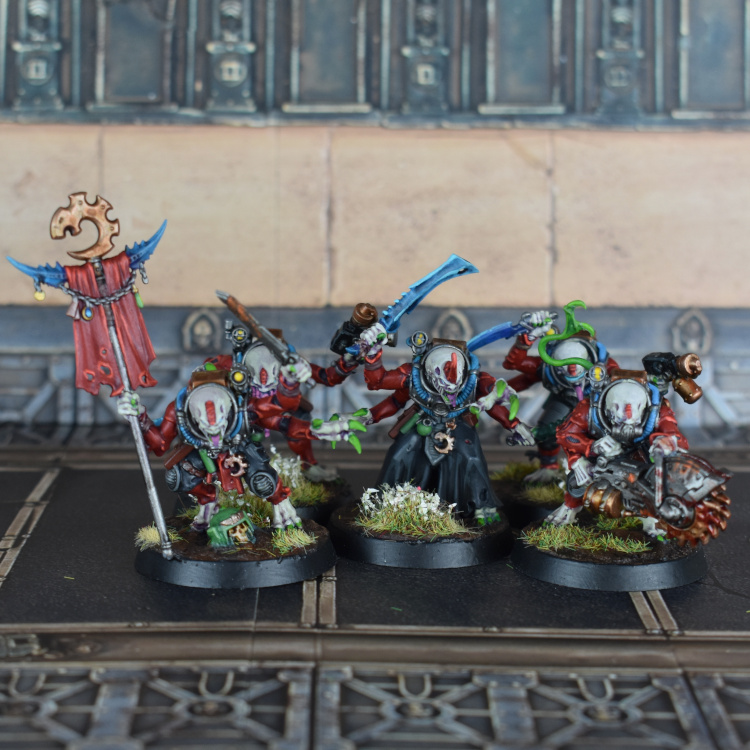
The other two Requisitions are more situational, but still solid. Blessed Leader lets you add a non-Patriarch character to your Order of Battle and immediately give it 6XP as long as you already had a Patriarch. And Beloved of the Cult lets you choose a unit at Heroic or higher rank and make it a celebrity. If it survives a battle and gains at least 1XP, every other unit in your army that survived gains 1XP on a d6 roll of 6. There’s just one catch: only one unit can be Beloved at a time. But if you change your mind on which one’s your favorite, all you have to do is buy the Requisition again, which allows you to remove it from the unit that currently has it and apply it to a new one.
All in all, these agendas are cool, and we think GSC will wind up being one of the more RP-hungry factions in the game. Proficient Planning offers you a great set of abilities that you’ll want to have available in as many games as possible, and Flawless Incursion dramatically speeds up how quickly you move toward a Glorious Ascension victory, so you’ll want to use that as often as possible too. Add in the fact that they’re likely to be rolling a lot of Out of Action tests, and you’ll likely find yourself looking for every opportunity to pick up an extra RP or two over the course of your campaign.
Crusade Relics
With over a dozen characters on offer to the Cult, they are going to require a diverse set of relics for every occasion. Thankfully, GW has delivered this in spades. Starting off with the Artificer Relics, the Pervasion Veil is a cloak that adds an additional 3” of movement to your Infantry character along with the powerful ability to remove them from the battlefield at the end of any phase, and then immediately set it up again anywhere more than 9” away from enemy models. You can only do it once per battle, and it only works if the model isn’t leading a unit, which makes this perfect for your Lone Operatives such as the Kelermorph or Sanctus. Being able to reposition from one side of the battlefield to another should never be overlooked. (Beanith: I’m picturing the look on my opponent’s face as I use this ability at the end of their charge phase. Not today sucker!) The Vector Talon is also a powerful choice, buffing the Armour Penetration and Damage of each of the model’s melee weapons by 1. Keen-eyed readers will also spot that this isn’t a weapon itself, so you can still use Weapon Modifications to further enhance the character into a vicious murder-blender on the field. (Condit: This can get particularly spicy with the Looted Armoury Ascension Perk, potentially allowing you to create history’s most anti-social Kelermorph.)
The Antiquity Relics are an odd couple. The Reverberation Coil improves the Leadership of models in the bearer’s unit by 2, which might come in handy because if you fail a Leadership test, the bearer suffers 1 mortal Wound. On the other hand, the Magorran Logs are an excellent little gift that lets you double-up on stratagems: when you use a Battle Tactic Stratagem on the bearer’s unit, you can also target another unit within 12” to get the same benefits.

Finally, we get to see what the Cult believes to be worthy of the Legendary tag. (Beanith: And while they tried to approach the greatness that is the Vortex Grenade, they tripped over the first hurdle right out of the gate.) The Pennant of Ascension is a fancy flag for your fancy-flag-waving Iconward which grants friendly Infantry and Mounted units within 6” of the bearer an additional attack to melee weapons. In the right list, this could be nasty, but if you want to use it you’ll need to make sure you can get it into position before the Iconward bites it. Meanwhile, Sedition Field worsens the Leadership and Objective Control of enemy battleline units within 9” by 1. Which sounds great until you realise I didn’t bold the word Battleline, and now you’re probably wondering just how often that will actually matter compared to something like a Reductus Saboteur with a Pervasion Veil and Vortex Grenade causing headaches.
All told, there are some neat options here, and while the Legendary relics aren’t quite as flashy as some of the options in other books, the Pennant of Ascension pairs nicely with a good number of units in the book. Meanwhile, either the Artificer options are great, and the Magorran Logs might single-handedly change the course of an entire game if you use it right.
Battle Scars
We’ve found that when a Codex has its own Battle Scars they tend to fall into one of two categories. The first one would be the Necrons-style ‘funny bad’ where there is an upside and downside to the Battle Scar and you may consider actually keeping the scar. The other one jumps right past the generic Battle Scar bad times and into the Custode/Tyranid ‘push your character into a wood chipper’ territory. Luckily for the Cult, GW has managed to hit the sweet spot and has come up with some suitable Battle Scars that, while still nasty, leave open the possibility that you may consider keeping the character around while you rustle up the required Requisition to remove this mark of shame from your Order of Battle.
Starting out the gate we have Out of Favour, which forces you to allocate attacks against the model’s unit to the model with the scar. On its face, it seems like it’d be one of the more punishing scars in the lot, but the way it interacts with the Leader datasheet ability leaves an open question as to whether it even works. Relearn the Creed restricts the Stratagems that the model and its unit can use to Core Stratagems, leaving them unable to benefit from some of the nastier tricks in the book. Mental Failings takes that step further and instead gives the model and its unit a 50/50 chance of being able to use any Stratagem. Gene Affliction reduces the model’s Toughness by 1 along with the WS and BS of each of its weapons, seriously reducing its effectiveness in combat. Fractious Aggression forces the model and attached unit to declare a charge any time an enemy is within 7” and an eligible target. Rounding out the bad times for your Cultists is In the Shadow of your Betters. This short story masquerading as a Battle Scar removes the ability for the model to join a squad that has a character already attached, and then slaps on a quasi-”fights last” condition which forces them to be chosen last among the eligible units with 9”. It’s complicated and situational for the most part.
You’re certainly not going to want to take these Battle Scars, as there’s no upside to doing so. But compared to several of the options in the generic table, these might not be quite as punishing, so they offer an interesting option when a character who can’t afford a Devastating Blow takes a Battle Scar.
Battle Traits
There’s four tables here, each with three possible results on them to share around your rag-tag bunch of “freedom fighters.” It may not sound like a lot, but with your Character-rich environment, many of them actually have access to more traits than you think: every Character in the book will qualify to choose from at least two tables, with the Patriarch managing to qualify for three. (Beanith: If only there was some way to mount them on a Wolfquad…)
Infantry units have access to some particularly fun upgrades that focus around survival and being an unhealthy target for charges. Guerrillas will give them the Benefit of Cover against ranged attacks. Insurgents allows them to use the Overwatch and Heroic Intervention Stratagems for 0CP while hanging out in cover. And Insurrectionists is a fairly powerful upgrade that adds 1 to hit rolls when targeting the closest unit at ranged, or any unit in melee.

Mounted and Vehicle units get some great upgrades that you will want to slam onto every unit possible from the tiny little Jackals to the bulky Rockgrinders. Right out the gate, we have Elusive Raiders which gives the unit a very nice 5+ invulnerable save against ranged attacks. Couple that with Charged Engines that replaces your Advance roll with a flat 6” and Ablative Plating that worsens the Armour Penetration of all incoming attacks by 1, and you can create some pretty nasty vehicle units.
Blessed are the Gene-Blessed for they are the angry stabby bitey ones in your Cult. This table is for the Patriarch, the Genestealers, and Hybrids and if you thought they were mean enough in melee already then strap in because it’s about to get nasty. Xenos Savagery grants the unit a once-per-battle ability to Fight First, making it perfect for surprise counter charges. Fast Reflexes straight-up makes the unit harder to be hit by subtracting 1 from melee hit rolls targeting them, and the Aggressive Strain adds on an additional 2” to Pile In and Consolidates. These are all fantastic abilities, and might go a long way to making Purestrains legitimate threats if you want to take a unit or two of them.
Last is the Character table, which offers some solid options that you may want to spread out across your units on the battlefield. Brood Prophet is an aura that improves the model’s Leadership by 1 and allows other Genestealer Cultists within 12” to use this model’s Leadership in place of their own, a neat trick to lessen the chance you’ll fail a key Battle-shock check. Synaptic Impetus rewards you for leading larger squads by giving the character +1 to Hit when leading a unit of 5 or models and an additional +1 to Wound in a squad of 10 or more. Rounding it out is the Unbreakable Bond, where the character forms a permanent, unbreakable bond with a bodyguard unit. You’ll note the two units on your Order of Battle, and whenever this character is leading that unit, they get to reroll one Hit roll, one Wound roll, or one saving throw per turn.
The traits here are nearly all good choices, and most of them lean in heavily to the Cults’ themes, which is great. The Gene-Blessed and Mounted/Vehicle tables are probably the standouts here for raw power, but the other two are interesting as well. Ultimately, this might be one of our favorite sets of Battle Traits in a codex so far.
Name Generator
As per Greg’s request, we are obligated to report that there is one included, it’s pretty sweet and Greg is still insisting that we refer to him as Greg, the Architect of Apotheosis, the Conquering Wyrm, and that I, Beanith, am his Twilit Knight.
Final Thoughts
Condit: Most of the stuff in this Codex is fantastic. The Battle Traits are great options, and while not all of the Crusade Relics are amazing, most of them are pretty darn good. You won’t want the Battle Scars, but they’re an interesting option for your characters compared to the ones in the Crusade rules. Most of the agendas are fun and flavorful, and Topple the False Temple remains one of the coolest ones they’ve put into any book so far.

And everything in the book is just dripping with theme: Toppling False Temples with Reductus Saboteur is a blast, the Crusade Relics and Battle Traits let you turn your Kelermorph into a gunslinger worthy of any tall tale, and putting Proficient Planning in as a requisition lets you keep in practice on your mustache-twirling even in a new edition with a new army rule.
But unfortunately, the main Crusade mechanic is just a bit too unwieldy. The addition of the Seed the Stars victory doesn’t really do much other than potentially slowing down your Glorious Ascension, especially given that the rewards for are somewhat anemic. And in an edition where everyone else can start cashing in their mechanics for rewards after 3 or 4 games, the Path to Ascension just takes far too long to walk as written.
That’s not to say it’s a bad mechanic, or that you shouldn’t engage with it. It just takes too long. There are plenty of ways for a motivated Campaign GM to shorten the length of time it would take to complete your Ascension, if you want to take a crack at it. And even if you don’t want to bother with the Path to Ascension at a weekender event, the rest of the book is absolutely worth it. If you play GSC in Crusade games, you definitely want these rules.
Beanith: Narratively this is brilliantly executed and just slaps but as pointed out by Condit, much like the poor Custodes, it does feel pretty rough waiting so long for the payout compared to say the Marines knocking out theirs over the course of 3 games. I like that there are plenty of Battle Traits to take but they aren’t all too powerful so you still want to take upgrades from Pariah Nexus or Levithan which prevents cookie cutter builds that 9th suffered from a lot. I was teetering on the fence on whether or not I want to expand on my Necromunda GSC gang but this may just be the push I needed to ‘accidentally’ build the biker gang I never knew I needed until now.

